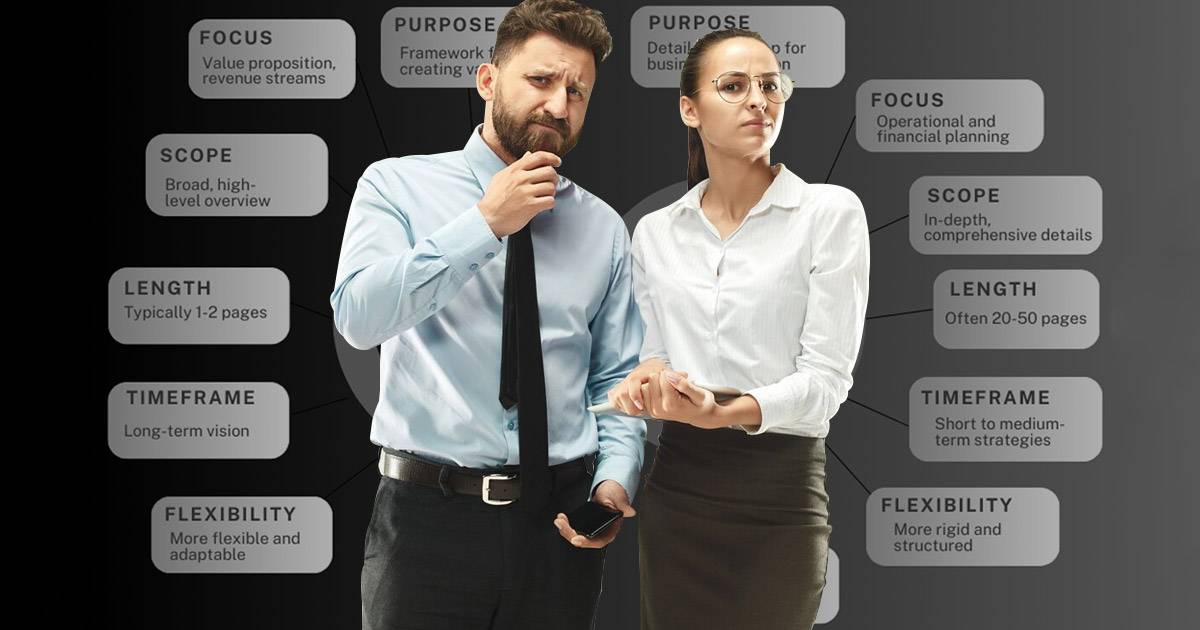Business Model vs Plan: Differences Every Entrepreneur Should Know

In business, two key terms come up often: business plan and business model. Both are essential, but they serve different purposes and have unique roles. Knowing the difference between them can be crucial to the success of your business.
Business Model and Business Plan – A Quick Look
A business model is your basic plan for making money. It defines what you’re selling, who will buy it, and how you’ll deliver it. Essentially, the business model explains how your business creates, delivers, and earns revenue. Your business model sets the direction for a business, giving you a focus for decisions on pricing, marketing, and customer experience.
Common examples include:
- Selling products straight to consumers.
- Charging a regular fee for ongoing services.
- Offering a free basic version and charging for premium features.
On the other hand, a business plan is a more detailed roadmap that outlines how you’ll reach your goals. A business plan is often essential for getting funding or partnerships, as it shows how the business will grow over time. A strong business plan is crucial for entrepreneurs to reach their goals. Studies show that 71% of fast-growing businesses use written plans regularly, while only 35% of smaller businesses do. Unlike the high-level overview of a business model, a business plan dives into specifics, covering areas like:
- Brief overview of your business and goals.
- Research on your industry, competitors, and customers.
- Details on how your business will run, including suppliers and partners.
- Estimates of income, expenses, and cash flow.
Business Model vs Business Plan: The Differences
Knowing the difference between a business model and a business plan is essential for good planning. Here are the main differences:
Purpose
A business model is a broad view of how the business makes money.
A business plan dives into the “how-to” for achieving financial and operational goals.
Focus
Business model provides a high-level overview of how the business operates.
Business plan includes an in-depth analysis of operational and financial strategies.
Level of Detail
Business models are usually short and simple.
Business plans are detailed, covering multiple sections like marketing, finance, and goals.
Length
Business model is usually brief, around 1-2 pages.
Business plan is often much longer, typically 20-50 pages, with detailed sections.
Timeframe
Business model focuses on the long-term vision for the business.
Business plan: outlines short- to medium-term strategies to achieve specific goals.
Audience
Business models are mainly used internally.
Business plans are often shared with investors, partners, or banks.
Adaptability
Business models are more flexible and can adapt to market changes.
Business plans are updated less often but should be revisited, especially as the business grows.
Flexibility
Business Model is more adaptable and easy to change as needed.
Business plan is more structured and requires formal revisions when changes are made.
The Relationship Between Business Model and Business Plan
The business plan and business model work together. The business model outlines how the company works, while the business plan turns those ideas into specific actions.
The business model sets the foundation for the strategy, and the business plan shows how to carry out that strategy. As the business grows, feedback from the plan can help tweak the business model to stay aligned with the market.
Because they rely on each other, entrepreneurs should create both at the same time for effective planning.
When to Use Each Tool
Using a Business Model
A business model is especially helpful in the early stages of a startup or when testing new ideas. The business model is flexible, allowing quick adjustments based on feedback, which makes it great for startups testing their concepts. Entrepreneurs can use it to:
- Identify target customers
- Define how they’ll make money
- Understand where they stand in the market
Using a Business Plan
A business plan is important when you need funding or need to guide day-to-day operations. It helps entrepreneurs:
- Present detailed analyses to investors or lenders
- Outline financial forecasts
- Set strategies for running the business
As the business grows or changes direction, it’s important to revisit and update the business plan to keep it aligned with new goals.
Why Entrepreneurs Should Revisit the Business Plan After Launching
After launching, things can change quickly. Customer needs may shift, competitors may adjust, and market conditions can fluctuate. That’s why entrepreneurs need to revisit their business plans. Here’s why:
- Helps you adapt to changes and stay ahead of the competition.
- Track your progress and adjust financial targets based on real results.
- Add new ideas, products, or services that weren’t included before.
For example, if your target audience turns out to be different than expected, revisiting the plan lets you change your marketing strategy to better reach them.
Integrating the Business Model and Business Plan for Success
Using both the business model and the business plan together helps ensure long-term success. Here’s how to make them work together:
- Start with a clear business model.
- Build your business plan to support the goals of your model.\
- As the market or your goals change, revisit both the model and the plan to keep things on track.
Aligning Your Business Model and Plan for Growth
The business model and business plan work together to guide a business. The model sets the direction, while the plan outlines the steps to get there. By using both and adjusting them as the business grows, entrepreneurs can stay on track and respond to changes in the market. This approach helps businesses stay focused on their goals while adapting to new opportunities and challenges.
